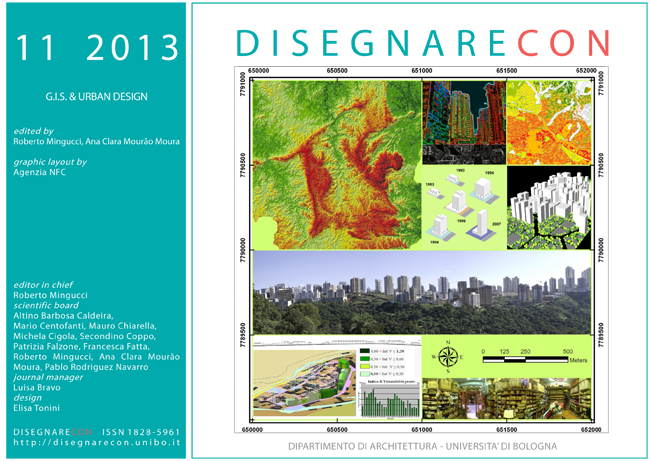Landscape morphology metrics for urban areas: analysis of the role of vegetation in the management of the quality of urban environment
DOI:
https://doi.org/10.6092/issn.1828-5961/3390Keywords:
Landscape Metrics, Urban Vegetation Cover, Urban land useAbstract
This study has the objective to demonstrate the applicability of landscape metric analysis undertaken in fragments of urban land use. More specifically, it focuses in low vegetation cover, arboreal and shrubbery vegetation and their distribution on land use. Differences of vegetation cover in dense urban areas are explained. It also discusses briefly the state-of-the-art Landscape Ecology and landscape metrics. It develops, as an example, a case study in Belo Horizonte, Minas Gerais, Brazil. For this study, it selects the use of the area’s metrics, the relation between area, perimeter, core, and circumscribed circle. From this analysis, this paper proposes the definition of priority areas for conservation, urban parks, free spaces of common land, linear parks and green corridors. It is demonstrated that, in order to design urban landscape, studies of two-dimension landscape representations are still interesting, but should consider the systemic relation between different factors related to shape and land use.
References
Bessa, A. M. (2012). Os espaços livres e a esfera da vida pública. Oficina da Biodiversidade Urbana, Universidade Federal de Minas Gerais. Slides de aula. 71 p.
Couto, P. 2004. Análise factorial aplicada a métricas da paisagem definidas em Fragstats. Investigação Operacional, Vol., 24, N°1, páginas. 109-137. Available: <http://www.scielo.oces.mctes.pt/pdf/iop/v24n1/24n1a07.pdf>. Access: 10th feb. 2010.
Eco, U. (1962). A obra aberta. São Paulo: Perspectiva, Tradução João R. N. Furtado, 186 p. 1989.
Falcón, A. (2007). Espacios verdes para una ciudad sostenible. Planificación, proyecto, mantenimiento y gestión. Barcelona: Editora Pili. 175 p.
Forman, R.T.T., Gordon, M. (1986). Landscape Ecology. New York, John Wiley & Sons.
Haines-Young, R.; Green, D. R.; Cousin, S. H. (Ed). (1993). Landscape Ecology and GIS. London: Taylor & Francis. 288 p.
Lang, S.; Blaschke, T. (2009). Análise da paisagem com SIG. São Paulo: Oficina de Textos. 424 p.
Leitão, A. B. et al. (2006). Measuring Landscapes – a planner’s handbook. Washington: IslandPress. 245 p.
McGarigal, K., Cushman S. A., Neel M. C., Ene, E. (2002). Fragstats: Spatial Pattern Analysis Program for Categorical Maps. Computer software program produced by the authors at the University of Massachusetts, Amherst. Available: . Access: 15th nov. 2009.
Metzger, J. P. (2001). O que é Ecologia de Paisagens? Biota Neotrópica. v.1, n. 1, p. 1-9.
Moura, A. C. M. (2010). Aplicações de modelos de mensuração de métricas de paisagem nos estudos da dinâmica de ocupação urbana no Quadrilátero Ferrífero e Região Metropolitana de Belo Horizonte – MG. Anais do XXIV Congresso Brasileiro de Cartografia, Aracaju-SE, p. 1545-1554.
Santos, A. R., Peluzio, T. M. O., Saito, N. S. (2010). SPRING 5.2.1: Passo a passo: Aplicações práticas. Alegre: CAUFES, 2010.
Turner, M. G.; Gardner, R. H. (Ed). (1991). Quantitative Methods in Landscape Ecology. New York: Springer. 836 p.
Downloads
Published
How to Cite
Issue
Section
License
Copyright (c) 2013 Danilo Marques de Magalhães, Ana Clara Mourão Moura





